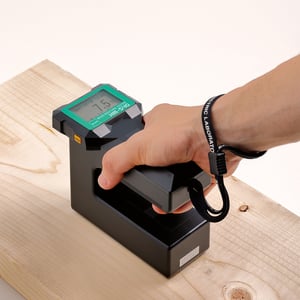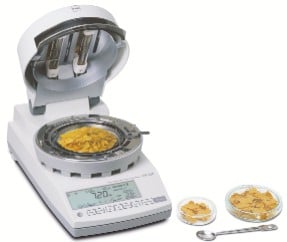 Whether you are installing brand-new drywall or checking the existing drywall in a structure compromised by moisture, you want to be sure you are accurate and thorough in your readings.
Whether you are installing brand-new drywall or checking the existing drywall in a structure compromised by moisture, you want to be sure you are accurate and thorough in your readings.
Installing, repairing, or replacing commercial and residential drywall requires precise work.
When drywall gets wet or absorbs too much moisture, it loses its structural integrity and becomes soft and weak—not adjectives anyone wants associated with their walls. Another risk with too much moisture is mold. Moldy walls or moldy drywall are not only unsightly, but also dangerous.
In order to be sure that your pre-existing or new drywall is in good shape, it’s vital for it to have the proper level of moisture. The most efficient way to ensure that your drywall is fit for installation or safe to keep is with the correct use of a top-quality moisture meter.
What level of moisture is safe?
Most houses have varying levels of humidity up to 50%, so moisture levels in drywall can vary from home to home. While relative humidity can have some effect on moisture levels, drywall is considered to have a safe level of moisture if it has a moisture content of between 5 and 12%. However, the ideal moisture content should be less than 1%.
Even a reading of up to 17% means that the drywall might be salvageable, but any moisture level above 17% tells us that the drywall has been compromised and will need to be replaced, or cannot be used.
In other words, if your moisture content is under 1%, you’re in great shape! Anything between 5 and 12% is likely safe, but should be monitored. 17% or higher, and you should begin remediation work.
Causes of moisture in drywall
Understanding the cause of drywall moisture is an essential part of remedying the issue. You don’t want to remediate moisture damage only to find out that it’s going to happen again from the same cause.
Excess moisture in drywall can come from numerous sources. Here are the most common sources of drywall moisture:
- Roof leaks or damaged shingles
- Plumbing leaks from pipes or fixtures
- Foundation cracks allowing groundwater seepage
- Poor exterior drainage around the building
- Flooding from natural disasters or burst pipes
- High indoor humidity levels
- Condensation from temperature differences
- HVAC system malfunctions or leaks
- Improperly sealed windows or doors
- Bathroom or kitchen steam without proper ventilation
- Sprinkler systems spraying against exterior walls
- Clogged or damaged gutters and downspouts
- New concrete or plaster still releasing moisture during curing
- Appliance leaks from washing machines, dishwashers, or water heaters
- Ice dams causing water backup under roofing
Common mistakes to avoid while testing drywall moisture
Even experienced professionals can fall into traps when it comes to moisture testing. Avoiding these common errors ensures accurate readings and better decision-making on every project.
Here are 10 important “don’ts” of drywall moisture management.
- Don’t test in just one location on the drywall
- Don’t assume the drywall is safe without testing the moisture content
- Don’t forget to calibrate the moisture meter before using it
- Don’t use a moisture meter that is not designed for testing drywall materials
- Don’t install new drywall before confirming that the moisture source has been eliminated
- Don’t test too soon after a water event, before the moisture has fully penetrated the materials
- Don’t rely on visual inspection or how the drywall feels
- Don’t ignore readings that are below 17% (monitor these readings for continued moisture migration)
- Don’t forget to document all of your moisture readings for future reference (as well as liability protection)
- Don’t forget to test the surrounding framing materials that could also be compromised
Who uses moisture meters?
Moisture meters for drywall aren't just useful for one type of professional. Instead, they are essential tools across multiple construction and restoration trades. Whether you're preventing problems during installation, diagnosing existing damage, or verifying that repairs meet industry standards, accurate moisture readings protect your work, your reputation, and your bottom line.
Here are some of the professionals who rely on moisture meters in their daily work:
- General contractors
- Drywall installation specialists
- Water damage restoration companies
- Building inspectors
- Property managers
- Roofing contractors
- HVAC technicians
- Mold remediation
- Insurance adjusters
- Home inspectors
- Painting contractors
- Facility maintenance teams
The business case for a good moisture meter
For construction companies and restoration professionals, a quality moisture meter is an investment that pays for itself many times over.
The cost of callbacks alone can quickly erode profit margins on any project. When drywall fails due to undetected moisture, contractors face not only the expense of materials and labor to replace it, but also the damage to their reputation and the potential loss of future business from dissatisfied clients.
Beyond preventing callbacks, moisture meters significantly reduce liability exposure. Water damage that goes undetected during installation or renovation can lead to mold growth, structural problems, and health concerns that may result in costly legal disputes or insurance claims.
By documenting proper moisture levels before and after work, contractors create a clear record that protects them from unwarranted liability. This documentation is particularly valuable when dealing with insurance companies or in situations where moisture problems arise from sources outside the contractor's control.
Choosing the right moisture meter
Kett offers several kinds of moisture meters that have the capacity to take accurate readings of drywall, including several near-infrared and universal moisture meters (all of which can be used for many, many purposes beyond drywall), but we also recommend our Advanced Instant Concrete Moisture Meter, which has calibrations specifically for use in taking readings of drywall. The upside of the near-infrared and concrete moisture meters is that they are non-destructive: they will not leave any unsightly holes in your drywall with each test.
Identifying signs of moisture
Before you use your moisture meter, give the drywall a visual once-over. Is the drywall discolored or crumbling? Is there a musty smell to it? If any of these signs are apparent, you can probably guess that the drywall has been exposed to too much moisture, and is maybe even beginning to grow mold that can be harmful to your home and your family.
This process of checking moisture is not an exact science, however. Issues as apparent as discoloration or crumbling mean that the drywall has gone unchecked, and has already experienced a prolonged exposure to moisture.
Because of this, even if drywall seems like it’s dry and structurally intact at first glance, it’s important to use a moisture meter to be absolutely certain that the drywall is safe to use (or safe to remain in its place), so you can catch water or moisture damage before its effects are visible to the eye and prevent a larger catastrophe.
How to get the most accurate moisture reading
In order to use the moisture meter accurately, first check to ensure that it is properly calibrated for use in testing drywall. An improper calibration will give you an inaccurate reading. When you are taking readings, be sure to take readings in multiple areas around the affected area, or throughout the entire sheet of drywall, if you’re planning to install it.
If you are testing the moisture content of pre-existing drywall, or drywall that has already been installed, it’s not only important to test in multiple areas for the most accurate reading, but also because multiple readings give you an idea of the full extent of any damage that has occurred.
Some drywall can be saved, if the moisture content is below 17%. Being able to focus remediation on the entire affected area ensures that the damage doesn’t spread, and that the drywall is saveable. Moisture spreads through drywall, so catching it early keeps the moisture from affecting other areas and causing further damage.
Kett provides high-quality, accurate moisture meters
Still have questions about which moisture meter to use or how to check drywall for moisture? At Kett, we are passionate about helping you find the perfect moisture meter for you and just as passionate about ensuring you feel confident in using it. Contact us today to see how we can help.


